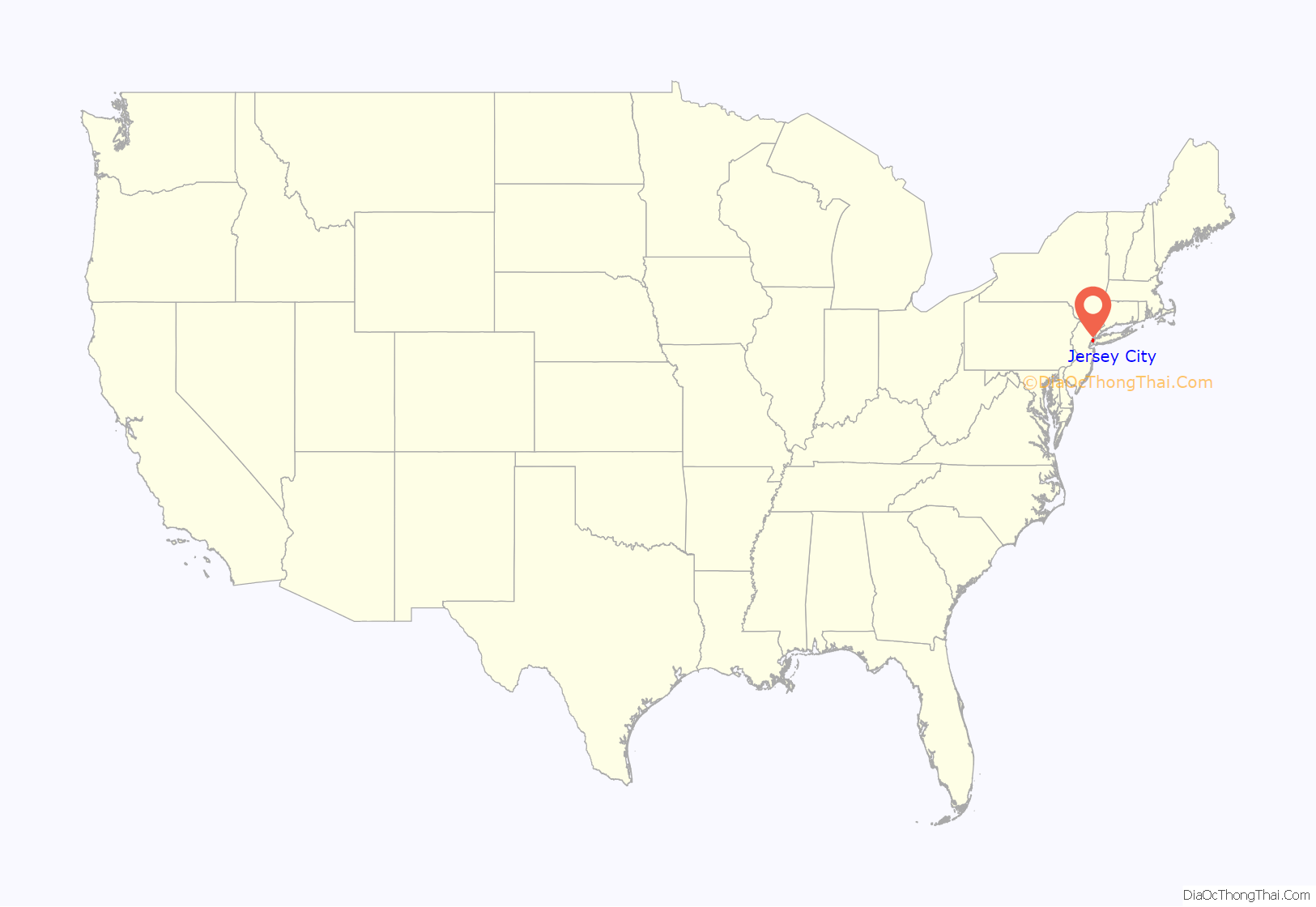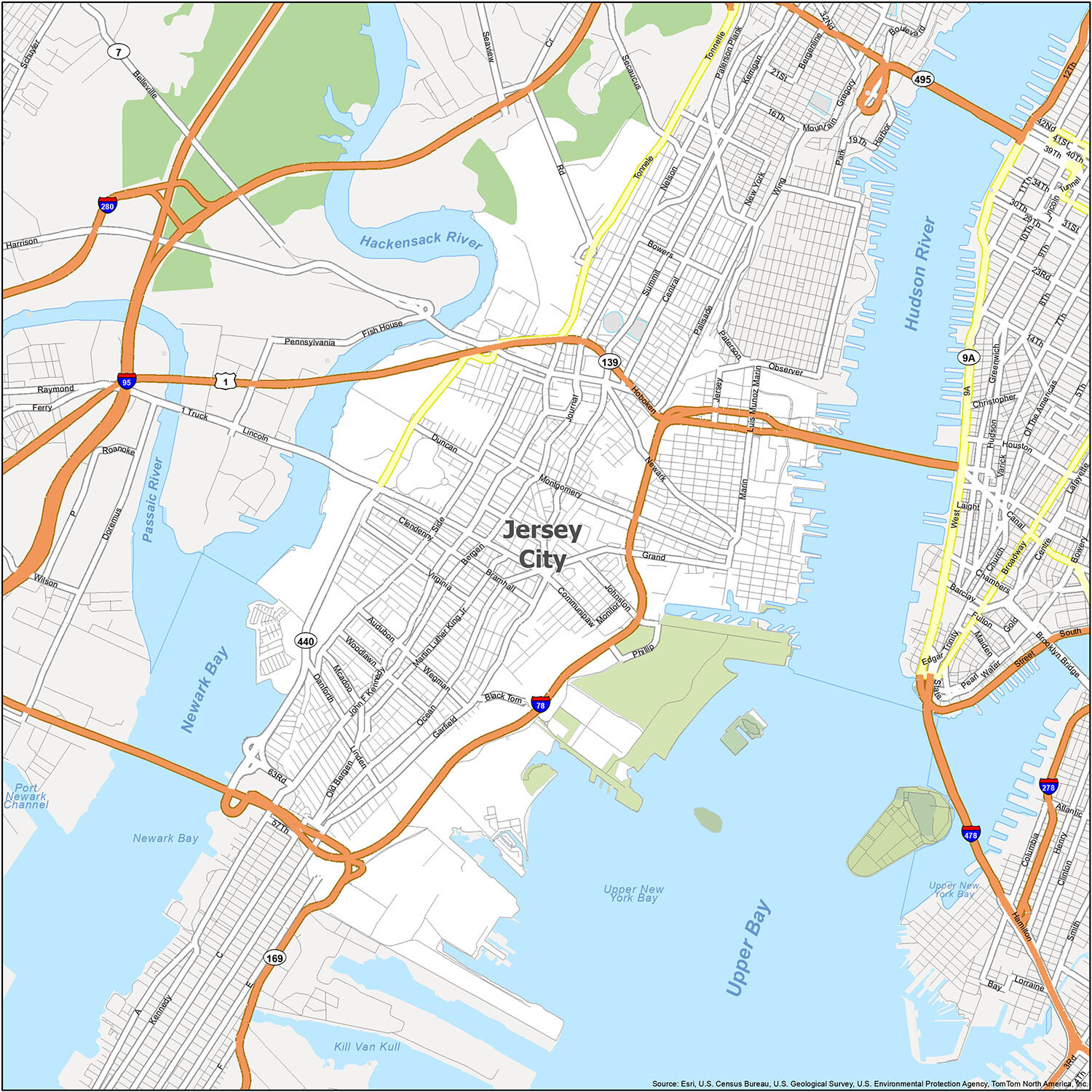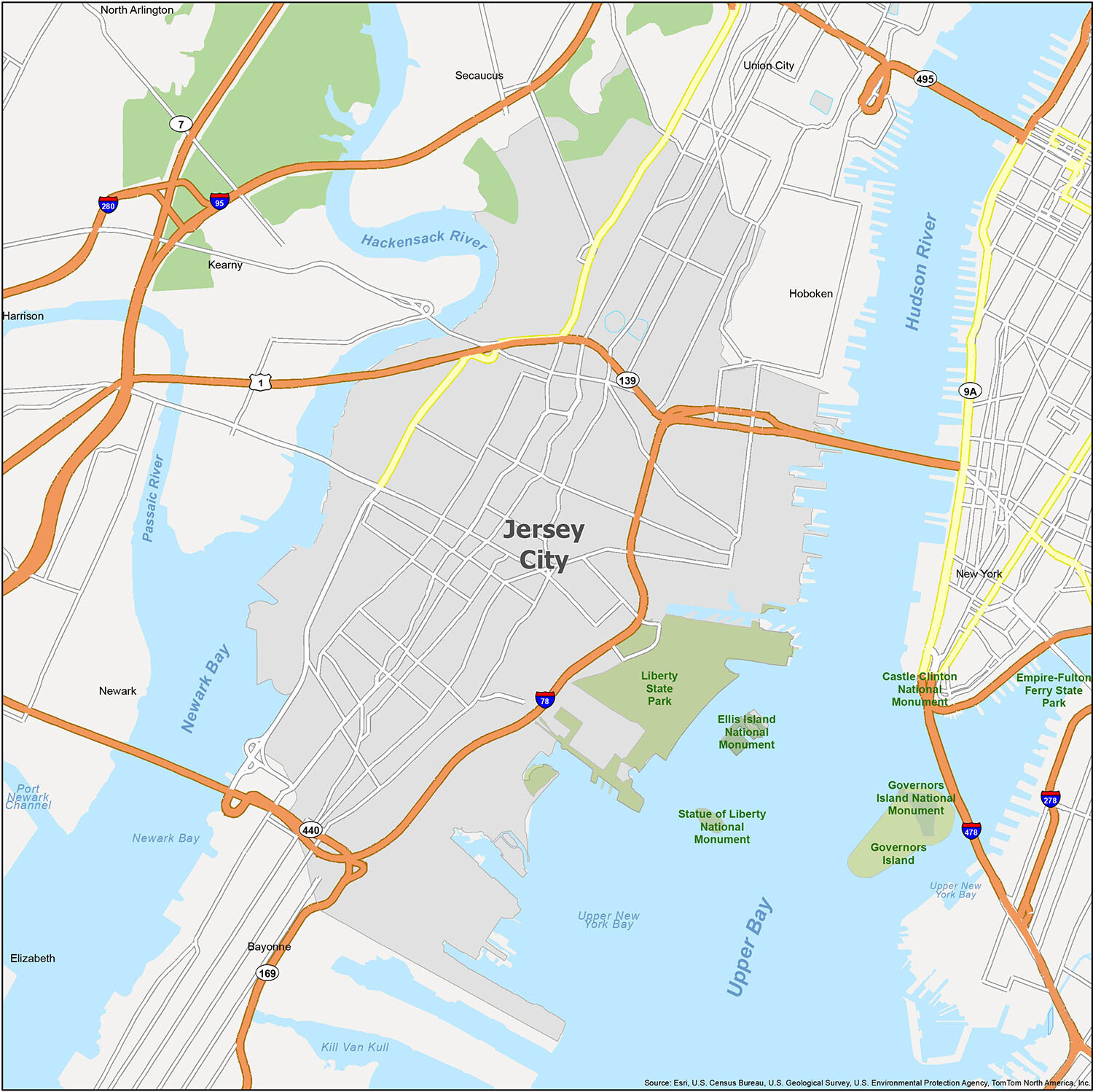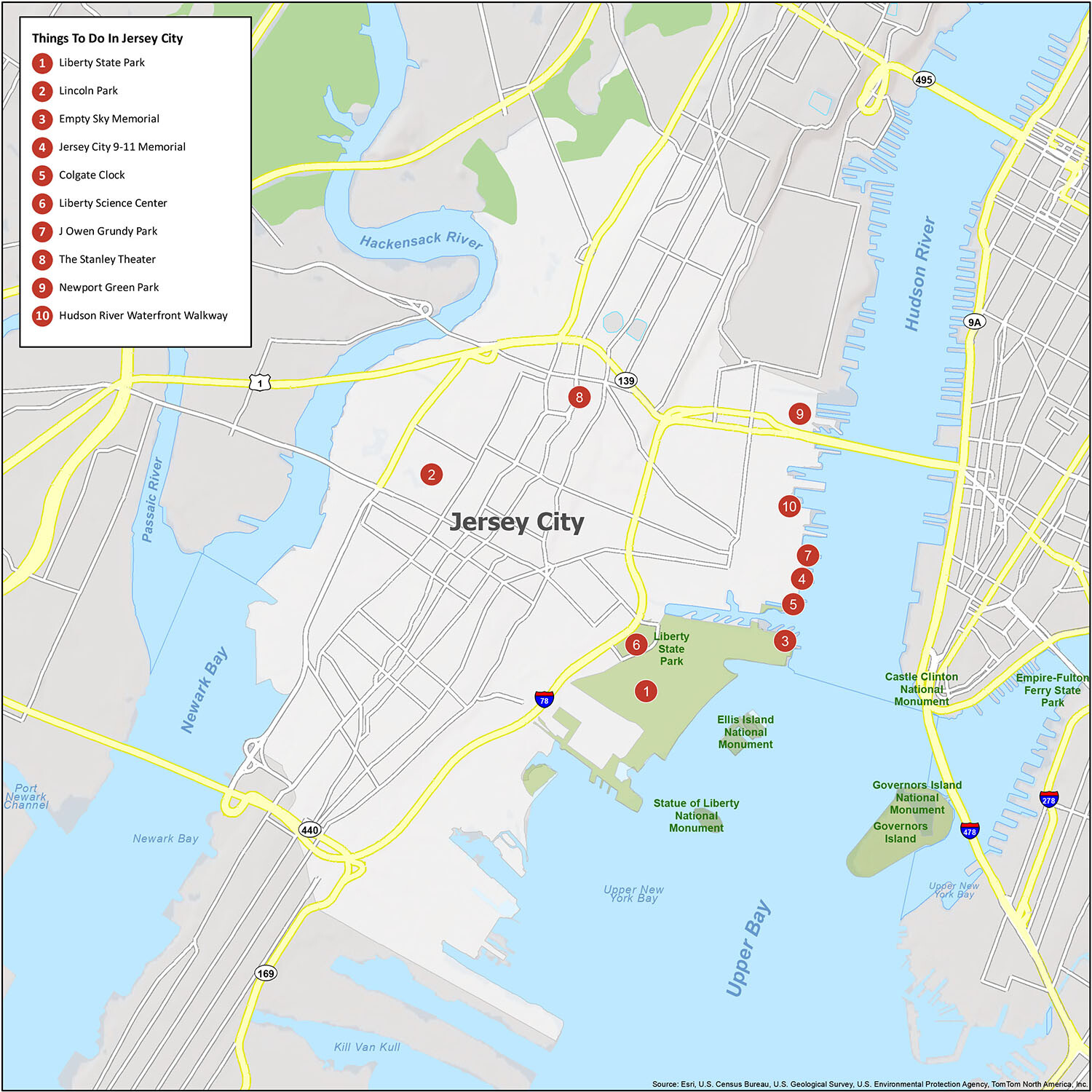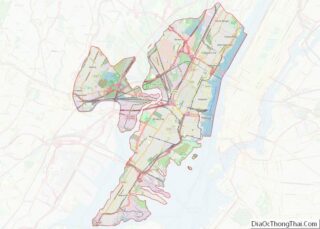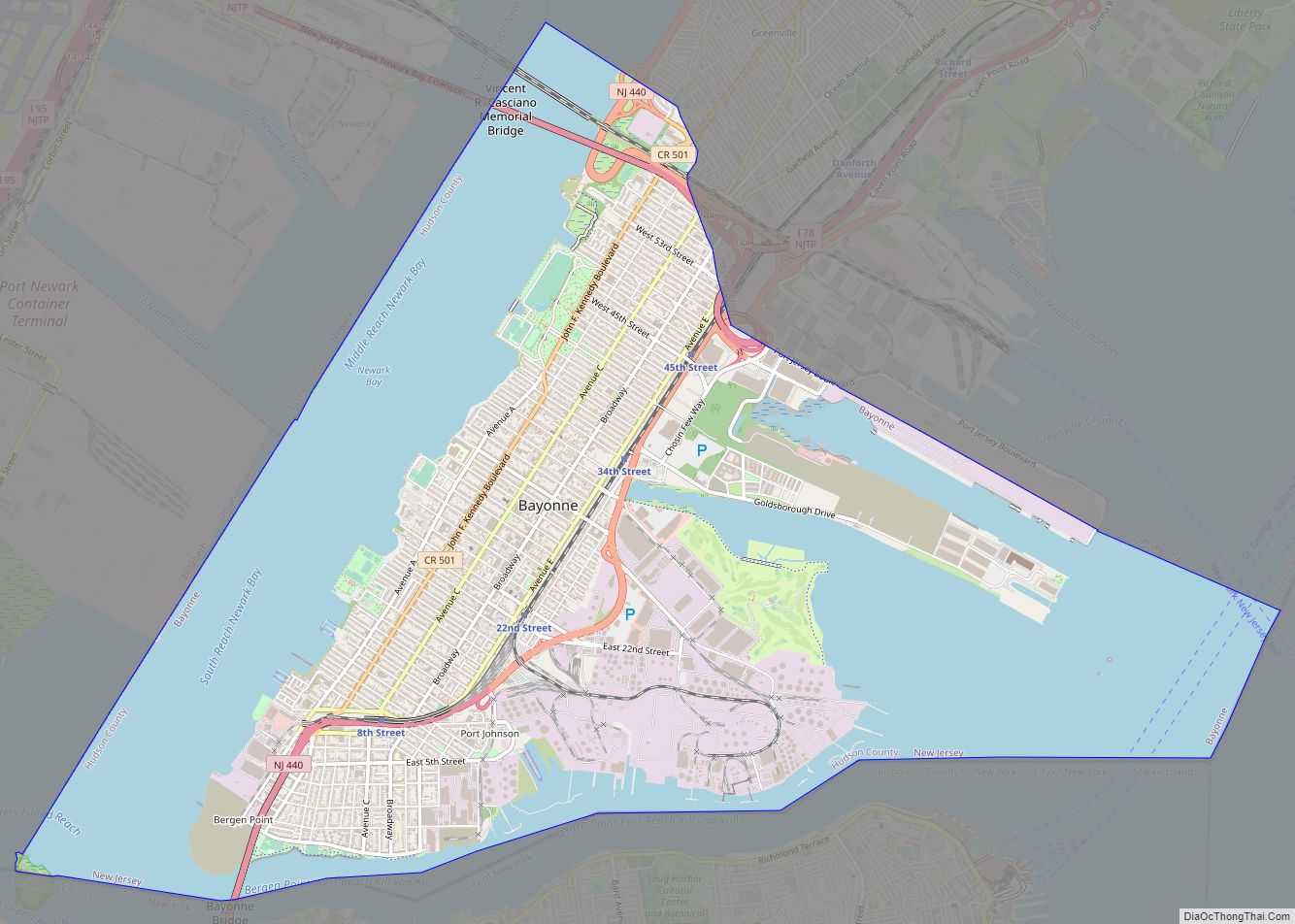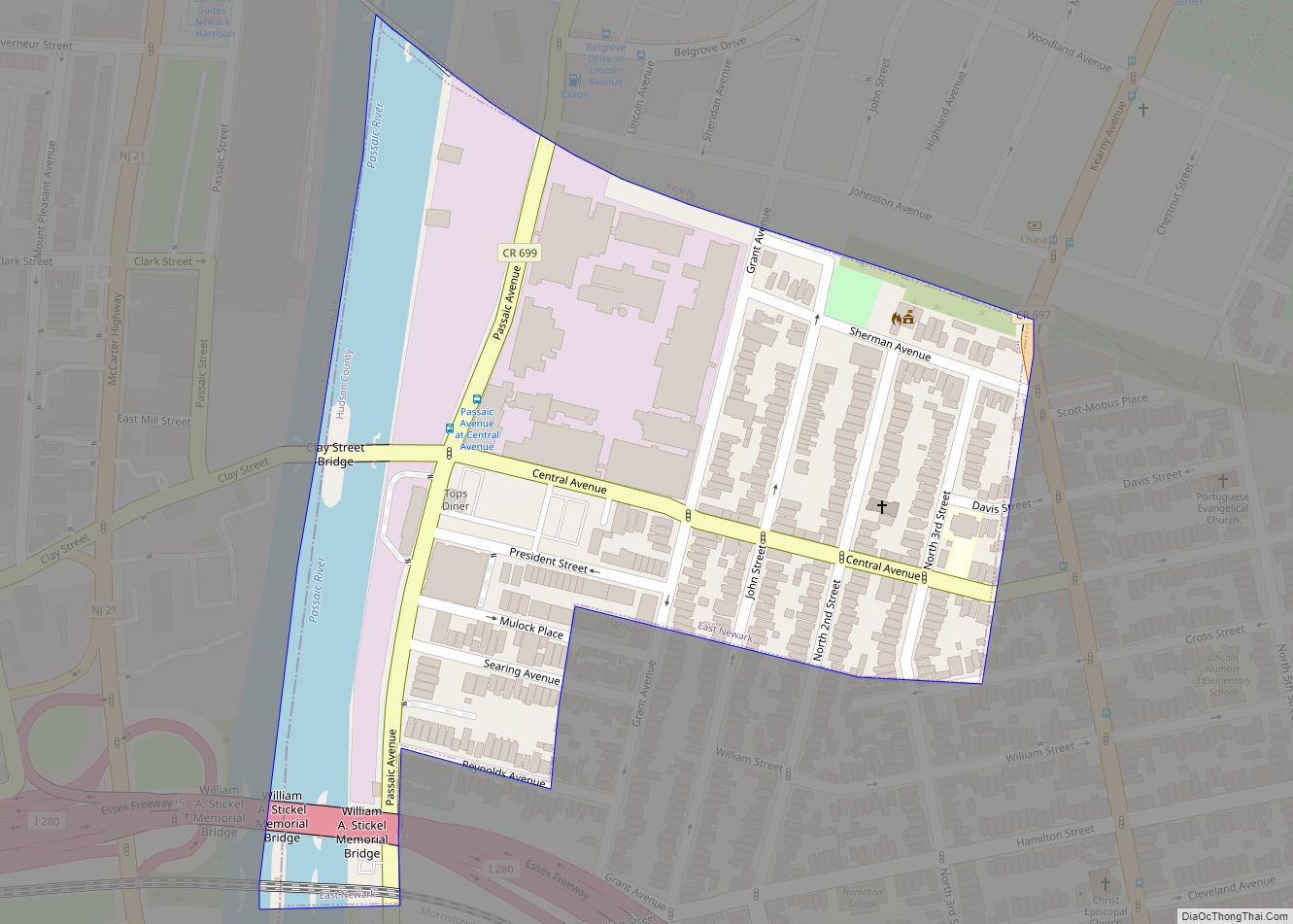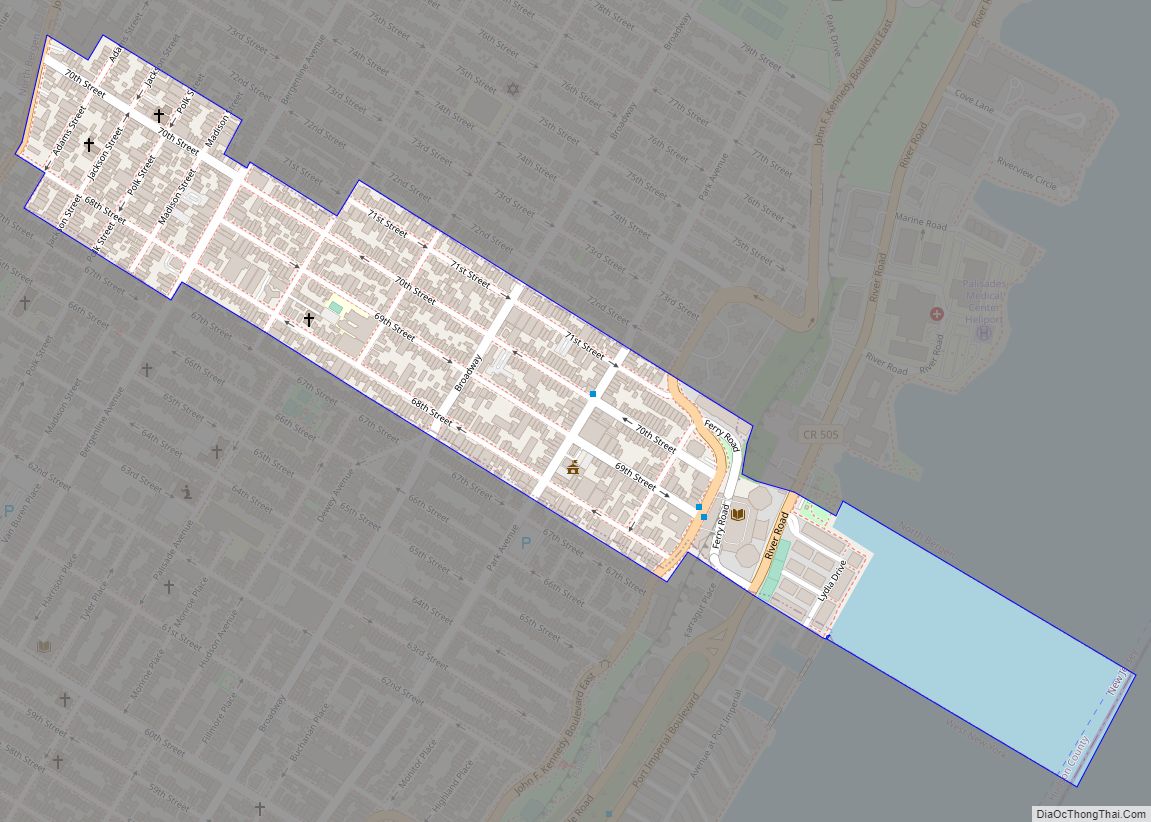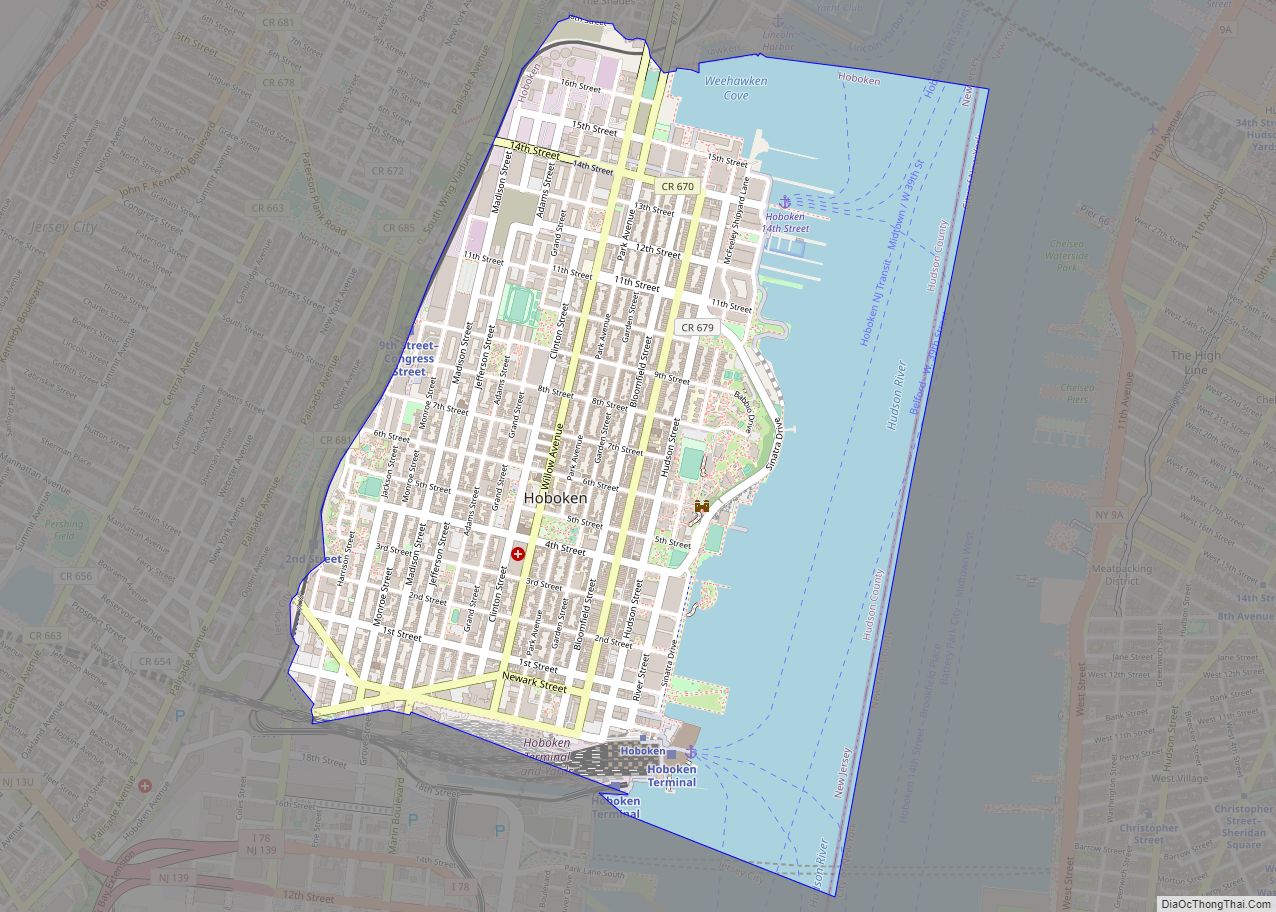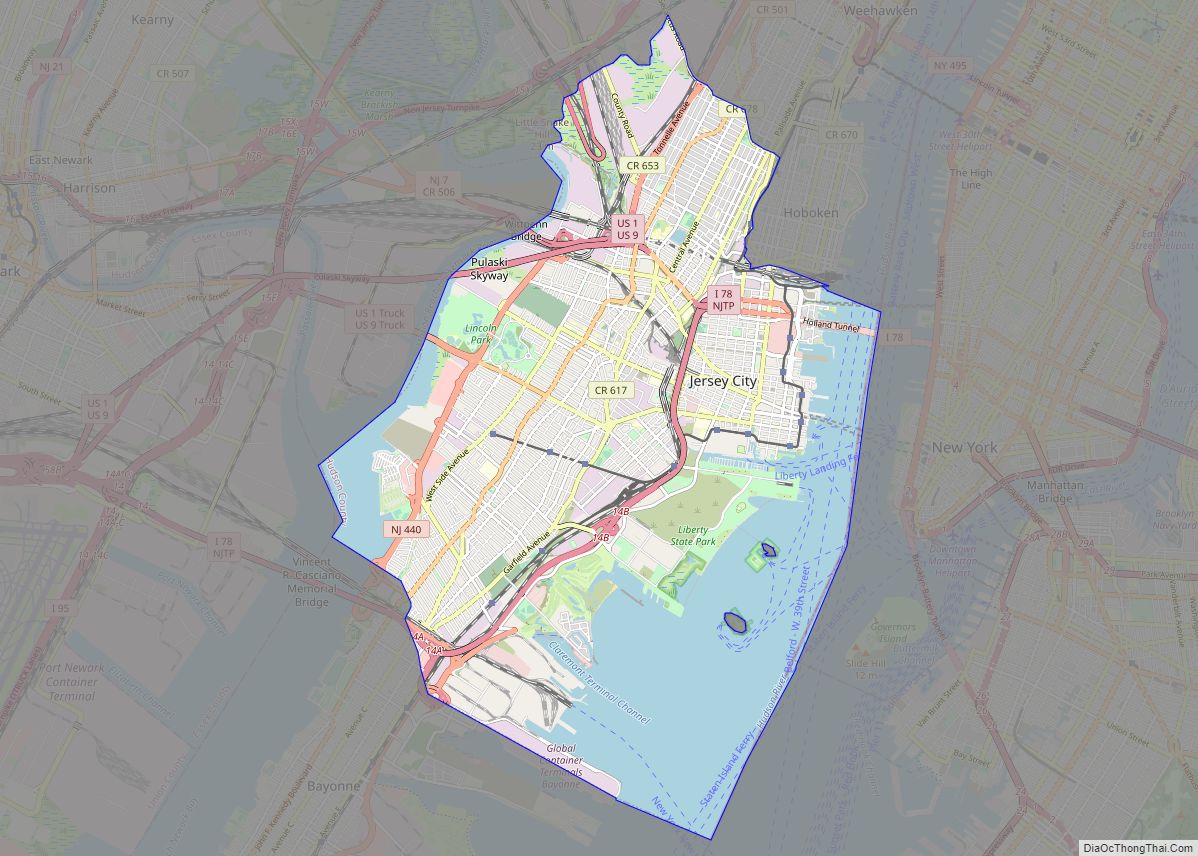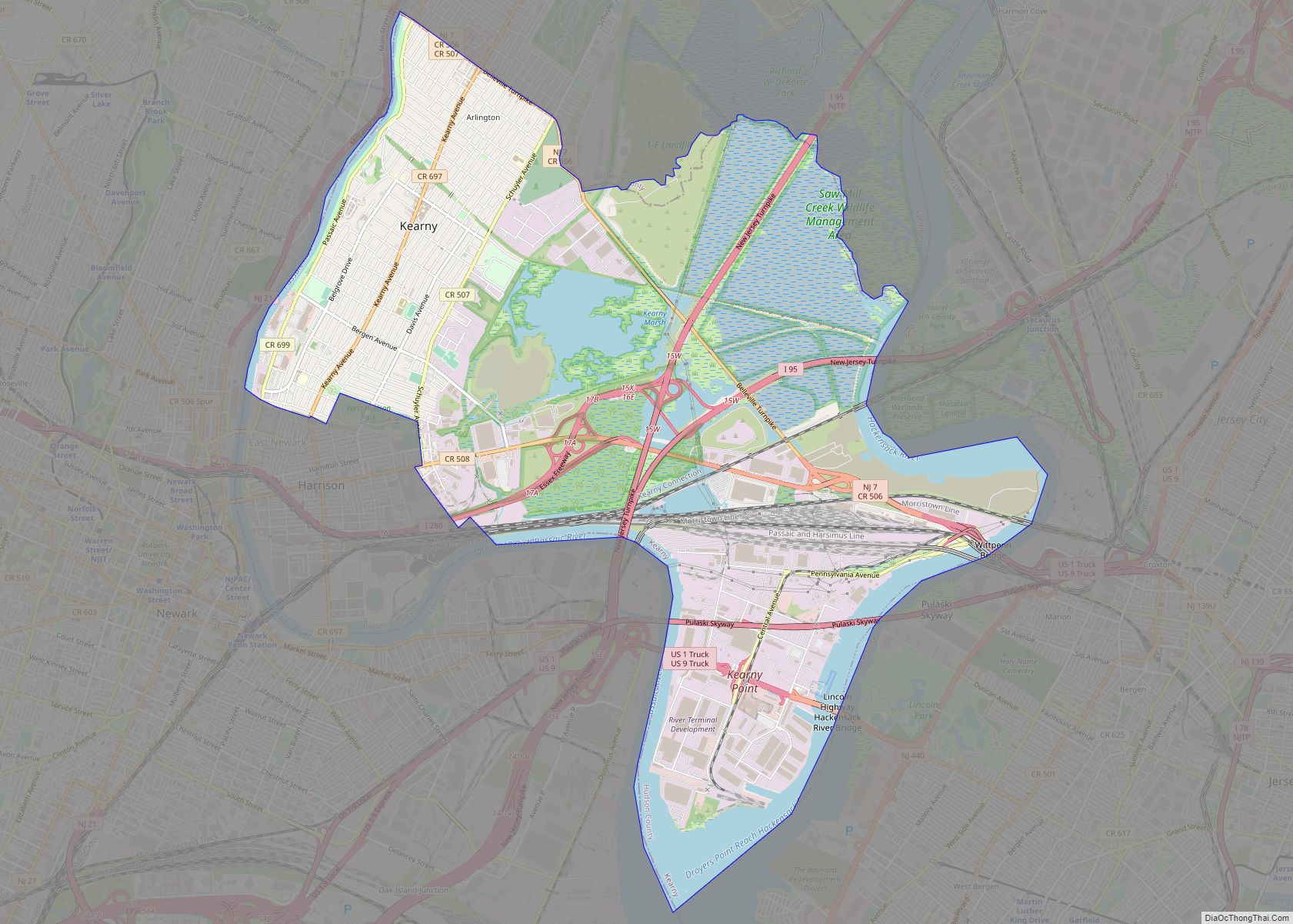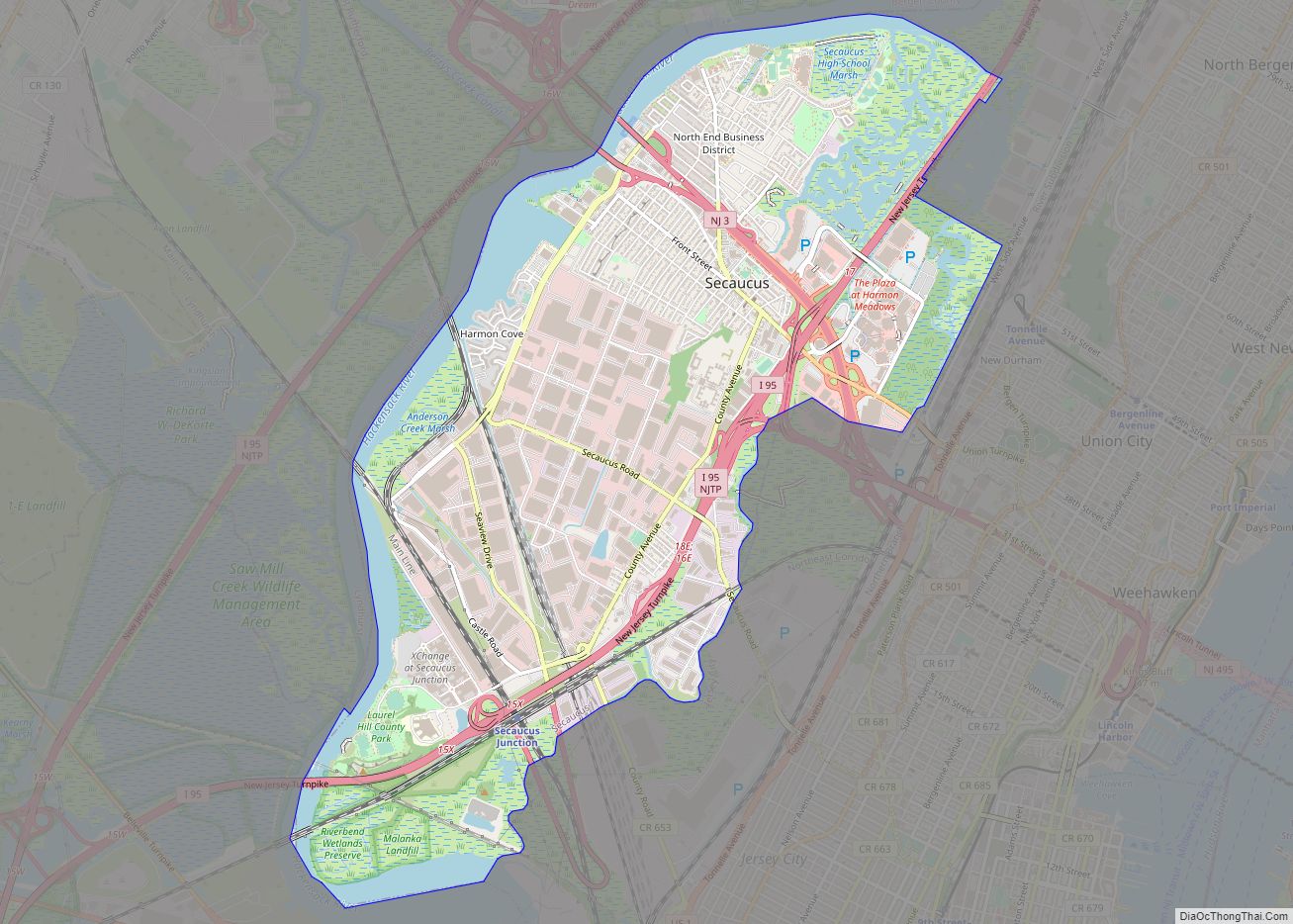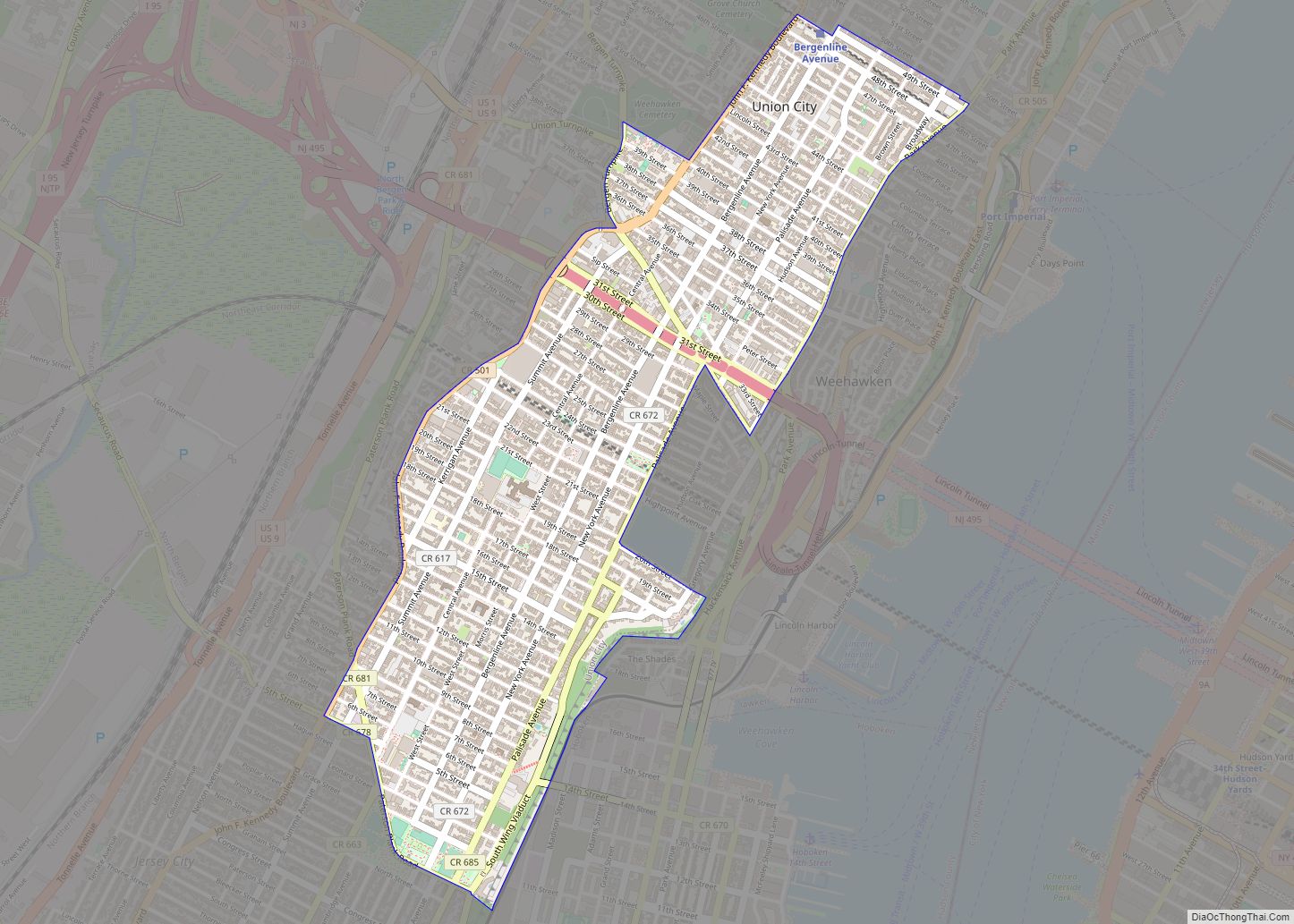Jersey City is the second-most populous city in the U.S. state of New Jersey, after Newark. It is the largest city and county seat of Hudson County As of the 2020 United States census, the city’s population was 292,449, an increase of 44,852 (+18.1%) from the 2010 census count of 247,597, in turn an increase of 7,542 (+3.1%) from the 240,055 enumerated at the 2000 census. The Census Bureau’s Population Estimates Program calculated that the city’s population was 283,927 in 2021, ranking the city the 75th-most-populous in the country.
Constituting part of the New York metropolitan area, Jersey City is bounded on the east by the Hudson River and Upper New York Bay and on the west by the Hackensack River and Newark Bay. A port of entry, with 30.7 miles (49.4 km) of waterfront and extensive rail infrastructure and connectivity, the city is an important transportation terminus and distribution and manufacturing center for the Port of New York and New Jersey. Jersey City shares significant mass transit connections with Manhattan. Redevelopment of the Jersey City waterfront has made the city one of the largest centers of banking and finance in the United States and has led to the district and city being nicknamed Wall Street West. By the early 2020s, the median rental rate in Jersey City had become the highest of any city in the United States.
| Name: | Jersey City city |
|---|---|
| LSAD Code: | 25 |
| LSAD Description: | city (suffix) |
| State: | New Jersey |
| County: | Hudson County |
| Incorporated: | February 22, 1838 |
| Elevation: | 20 ft (6 m) |
| Total Area: | 21.03 sq mi (54.48 km²) |
| Land Area: | 14.75 sq mi (38.20 km²) |
| Water Area: | 6.29 sq mi (16.28 km²) 30.24% |
| Total Population: | 292,449 |
| Population Density: | 19,835.1/sq mi (7,658.4/km²) |
| Area code: | 201/551 |
| FIPS code: | 3436000 |
| GNISfeature ID: | 0885264 |
| Website: | www.jerseycitynj.gov |
For a printable map of Jersey City, you don’t have to look any further. We have highlighted major roads, reference information and things to do. If you need an interactive map of Jersey City, explore the city with our Google Maps map below.
If you are looking for a place to live or a vacation destination, Jersey City is the perfect choice. With a population of over 260,000 people, the city is one of the most ethnically diverse in the country. It is also one of the most exciting places to live in the state, with vibrant communities and a booming economy.
To explore the city, there is no better way than with a map in your hand. Our printable map of Jersey City is the perfect tool to help you find all the best places to visit and enjoy your stay.
Online Interactive Map
Click on ![]() to view map in "full screen" mode.
to view map in "full screen" mode.
Our interactive map is your guide to the best things to do, see, and eat in Jersey City. It includes photos of some of the best spots in the city. It also provides key information including locations of restaurants, bars and shops, parks, sights, and more. Find out what’s nearby, find your way to the top attractions, and locate the perfect places to eat and sleep.
Jersey City location map. Where is Jersey City city?
History
Lenape and New Netherland
The land comprising what is now Jersey City was inhabited by the Lenape, a collection of Native American tribes (later called Delaware Indian). In 1609, Henry Hudson, seeking an alternate route to East Asia, anchored his small vessel Halve Maen (English: Half Moon) at Sandy Hook, Harsimus Cove and Weehawken Cove, and elsewhere along what was later named the North River. After spending nine days surveying the area and meeting its inhabitants, he sailed as far north as Albany. The contemporary flag of the city is a variation on the Prince’s Flag from the Netherlands. The stripes are blue, white and yellow, with the center of the flag showing the city seal, depicting Hudson’s ship, the Half Moon, and other modern vessels.
By 1621, the Dutch West India Company was organized to manage this new territory and in June 1623, New Netherland became a Dutch province, with headquarters in New Amsterdam. Michael Reyniersz Pauw received a land grant as patroon on the condition that he would establish a settlement of not fewer than fifty persons within four years. He chose the west bank of the Hudson River and purchased the land from the Lenape. This grant is dated November 22, 1630, and is the earliest known conveyance for what are now Hoboken and Jersey City. Pauw, however, was an absentee landlord who neglected to populate the area and was obliged to sell his holdings back to the Company in 1633. That year, a house was built at Communipaw for Jan Evertsen Bout, superintendent of the colony, which had been named Pavonia (the Latinized form of Pauw’s name, which means “peacock”). Shortly after, another house was built at Harsimus Cove and became the home of Cornelius Van Vorst, who had succeeded Bout as superintendent, and whose family would become influential in the development of the city. Relations with the Lenape deteriorated, in part because of the colonialist’s mismanagement and misunderstanding of the indigenous people, and led to series of raids and reprisals and the virtual destruction of the settlement on the west bank. During Kieft’s War, approximately eighty Lenapes were killed by the Dutch in a massacre at Pavonia on the night of February 25, 1643.
Scattered communities of farmsteads characterized the Dutch settlements at Pavonia: Communipaw, Harsimus, Paulus Hook, Hoebuck, Awiehaken, Pamrapo, and other lands “behind Kill van Kull”. The village of Bergen (located inside a palisaded garrison) was established on what is now Bergen Square in 1660 and officially chartered on September 5, 1661, as the state’s first local civil government. As a result, it is regarded as the first permanent settlement and oldest municipality in what would become the state of New Jersey. In addition, the oldest surviving houses in Jersey City are of Dutch origin including the Newkirk House (1690), the Van Vorst Farmhouse (1740), and the Van Wagenen House (1740).
19th century
In 1804, Alexander Hamilton, now a private citizen, was focused on increasing manufacturing in the greater New York City area. To that end, he helped to create the Associates of the Jersey Company which would lay the groundwork for modern Jersey City through private development. The consortium behind the company were predominantly Federalists who, like Hamilton, had been swept out of power in the election of 1800 by Thomas Jefferson and other Democratic-Republicans. Large tracts of land in Paulus Hook were purchased by the company with the titles owned by Anthony Dey, who was from a prominent old Dutch family, and his two cousins, Colonel Richard Varick, the former mayor of New York City (1789–1801), and Jacob Radcliff, a Justice of the New York Supreme Court who would later become mayor of New York City (twice) from 1810 to 1811 and again from 1815 – 1818. They laid out the city squares and streets that still characterize the neighborhood, giving them names also seen in Lower Manhattan or after war heroes (Grove, Varick, Mercer, Wayne, Monmouth and Montgomery among them).
Despite Hamilton’s untimely death in August 1804, the Association carried on, though the enterprise was mired in a legal dispute between New York City and the state of New Jersey over who owned the waterfront. The unresolved dispute would continue until the Treaty of 1834 where New York City formally ceded control of Jersey City to New Jersey. Over that time though, the Jersey Company applied to the New Jersey Legislature to incorporate the Town of Jersey. The legislature enacted “An Act to incorporate the City of Jersey, in the County of Bergen” on January 28, 1820. Under the provision, five freeholders (including Varick, Dey, and Radcliff) were to be chosen as “the Board of Selectmen of Jersey City,” thereby establishing the first governing body of the emerging municipality. The city was reincorporated on January 23, 1829, and again on February 22, 1838, at which time it became completely independent of North Bergen and was given its present name. On February 22, 1840, it became part of the newly created Hudson County.
During the 19th century, former slaves reached Jersey City on one of the four routes of the Underground Railroad that led to the city.
Soon after the Civil War, the idea arose of uniting all of the towns of Hudson County east of the Hackensack River into one municipality. A bill was approved by the state legislature on April 2, 1869, with a special election to be held on October 5, 1869. An element of the bill provide that only contiguous towns could be consolidated. While a majority of the voters across the county approved the merger, the only municipalities that had approved the consolidation plan and that adjoined Jersey City were Hudson City and Bergen City. The consolidation began on March 17, 1870, taking effect on May 3, 1870. Three years later the present outline of Jersey City was completed when Greenville agreed to merge into the Greater Jersey City.
In the late 1880s, three passenger railroad terminals opened in Jersey City next to the Hudson River (Pavonia Terminal, Exchange Place and Communipaw). Tens of millions of immigrants passed through these stations as they made their way westward from Ellis Island into the United States. The railroads transformed the geography of the city by building the Erie Cut as well as several large freight rail yards.
20th and 21st centuries
Jersey City was a dock and manufacturing town for much of the 19th and 20th centuries. Much like New York City, Jersey City has always been a destination for new immigrants to the United States. In its heyday before World War II, German, Irish, and Italian immigrants found work at Colgate, Chloro or Dixon Ticonderoga. In 1908, the first permanent disinfection system for drinking water in the U.S. was installed on the water supply for the city by John L. Leal. The Hudson Tubes opened in 1911, allowing passengers to take the train to Manhattan as an alternative to the extensive ferry system. The Black Tom explosion occurred on July 30, 1916, as an act of sabotage on American ammunition supplies by German agents to prevent the materials from being used by the Allies in World War I.
From 1917 to 1947, Jersey City was governed by Mayor Frank Hague. Originally elected as a candidate supporting reform in governance, the Jersey City History website says his name is “synonymous with the early twentieth century urban American blend of political favoritism and social welfare known as bossism”. Hague ran the city with an iron fist while, at the same time, molding governors, United States senators, and judges to his whims. Boss Hague was known to be loud and vulgar, but dressed in a stylish manner, earning him the nickname “King Hanky-Panky”. In his later years in office, Hague would often dismiss his enemies as “reds” or “commies”. Hague lived like a millionaire, despite having an annual salary that never exceeded $8,500. He was able to maintain a fourteen-room duplex apartment in Jersey City, a suite at the Plaza Hotel in Manhattan, and a palatial summer home in the seaside community of Deal, and travel to Europe yearly in the royal suites of the best ocean liners.
After Hague’s retirement from politics, a series of mayors including John V. Kenny, Thomas J. Whelan and Thomas F. X. Smith attempted to take control of Hague’s organization, usually under the mantle of political reform. None were able to duplicate the level of power held by Hague, but the city and the county remained notorious for political corruption for years. By the 1970s the city experienced a period of urban decline that saw many of its wealthy residents leave for the suburbs, due to rising crime, civil unrest, political corruption, and economic hardship. From 1950 to 1980, Jersey City lost 75,000 residents, and from 1975 to 1982, it lost 5,000 jobs, or 9% of its workforce.
Beginning in the 1980s, development of the waterfront in an area previously occupied by rail yards and factories helped to stir the beginnings of a renaissance for Jersey City. The rapid construction of numerous high-rise buildings increased the population and led to the development of the Exchange Place financial district, also known as “Wall Street West”, one of the largest financial centers in the United States. Large financial institutions such as UBS, Goldman Sachs, Chase Bank, Citibank, and Merrill Lynch occupy prominent buildings on the Jersey City waterfront, some of which are among the tallest buildings in New Jersey. Simultaneous to this building boom, the light-rail network was developed. With 18,000,000 square feet (1,700,000 m) of office space as of 2011, it has the nation’s 12th-largest downtown.
City Ordinance 13.097, passed in October 2013, requires employers with ten or more employees to offer up to five paid sick days a year. The bill impacts all businesses employing workers who work at least 80 hours a calendar year in Jersey City.
Jersey City Road Map
Explore the city and find your way to your destination with this road map of Jersey City. Although its location might not seem enticing at first, Jersey City is one of the most connected cities in the metro area. Our map is the perfect tool for getting around the city. See the major highways and road network of Jersey City so you can find your way around the city. This map is free and ideal for planning your next adventure designed for easy navigation.
Interstate Highways: I-78
US Highways: 1, 7, 78, 139, 169, 440, 501, 681
Parkways/Expressways: Wegman Pky
Major Roads: 5th St, 12th St, 14th St, Audubon Ave, Belmont Ave, Bennett St, Bergen Ave, Black Tom Rd, Bowers St, Bramhall Ave, Broadway, Central Ave, Christopher Columbus Dr, Clendenny Ave, Communipaw Ave, Danforth Ave, Duncan Ave, Garfield Ave, Grand St, Hoboken Ave, Ivy Pl, Jersey Ave, John F Kennedy Blvd, Johnston Ave, Journal Sq, Linden Ave, Long St, Luis Munoz Marin Blvd, Manhattan Ave, Marin Blvd, Martin Luther King Jr Dr, Mcadoo Ave, Merritt St, Monitor St, Montgomery St, Nelson Ave, Newark Ave, Newark St, Oakland Ave, Ocean Ave, Old Bergen Rd, Palisade Ave, Paterson Plank Rd, Phillip St, Rd, Rose Ave, Secaucus Rd, Side Ave, Sipersteins Plz, Summit Ave, Tonnele Ave, Van Nostrand Ave, Virginia Ave, Wing Via, Woodlawn Ave
Planning to travel outside the city? Take a look at our New Jersey road map that you can use for free.
Explore the diverse and urban city of Jersey City with this comprehensive and easy-to-use reference map. Get a real taste of the city and its neighborhoods, and discover the many parks, monuments, and bays that the city has to offer. Whether you’re looking to move to or visit Jersey City, this reference map is the perfect way to get started!
The city of Jersey City includes the cities of Bayonne, Hoboken, Jersey City, New York, Newark, Union City, the towns of Kearny and Secaucus, and the borough of North Arlington. The map also features the water features of Hackensack River, Hudson River, Kill Van Kull, Newark Bay, Passaic River, Port Newark Channel, and Upper Bay, as well as the parks of Berry Lane Park, Liberty State Park, Lincoln Park, Mary Benson Park, and Hamilton Park.
10 things to do in Jersey City city
Our interactive map is your guide to the best things to do, see, and eat in Jersey City. It includes photos of some of the best spots in the city. It also provides key information including locations of restaurants, bars and shops, parks, sights, and more. Find out what’s nearby, find your way to the top attractions, and locate the perfect places to eat and sleep.
Jersey City city Satellite Map
Geography
Jersey City is the seat of Hudson County and the second-most-populous city in New Jersey. According to the United States Census Bureau, the city had a total area of 21.13 square miles (54.74 km), including 14.74 square miles (38.19 km) of land and 6.39 square miles (16.55 km) of water (30.24%). As of the 1990 census, it had the smallest land area of the 100 most populous cities in the United States.
Jersey City is bordered to the east by the Hudson River, to the north by Secaucus, North Bergen, Union City and Hoboken, to the west, across the Hackensack River, by Kearny and Newark, and to the south by Bayonne.
Jersey City includes most of Ellis Island (the parts awarded to New Jersey by the 1998 U.S. Supreme Court in the case of New Jersey v. New York). Liberty Island is surrounded by Jersey City waters in the Upper New York Bay. Given their proximity and accessibility by rapid transit to Manhattan, Jersey City and Hudson County are sometimes referred to as New York City’s Sixth borough.
Jersey City (and most of Hudson County) is located on the peninsula known as Bergen Neck, with a waterfront on the east at the Hudson River and New York Bay and on the west at the Hackensack River and Newark Bay. Its north–south axis corresponds with the ridge of Bergen Hill, the emergence of the Hudson Palisades. The city is the site of some of the earliest European settlements in North America, which grew into each other rather than expanding from a central point. This growth and the topography greatly influenced the development of the sections of the city and its various neighborhoods.
Neighborhoods
The city is divided into six wards.
Bergen-Lafayette, formerly Bergen City, New Jersey, lies between Greenville to the south and McGinley Square to the north, while bordering Liberty State Park and Downtown to the east and the West Side neighborhood to the west. Communipaw Avenue, Bergen Avenue, Martin Luther King Drive, and Ocean Avenue are main thoroughfares. The former Jersey City Medical Center complex, a cluster of Art Deco buildings on a rise in the center of the city, has been converted into residential complexes called The Beacon. Completed in 2016 at a cost of $38 million, Berry Lane Park is located along Garfield Avenue in the northern section of Bergen-Lafayette; covering 17.5 acres (7.1 ha), it the largest municipal park in Jersey City.
Downtown Jersey City is the area from the Hudson River westward to the Newark Bay Extension of the New Jersey Turnpike (Interstate 78) and the New Jersey Palisades; it is also bounded by Hoboken to the north and Liberty State Park to the south.
Historic Downtown is an area of mostly low-rise buildings to the west of the waterfront that is highly desirable due to its proximity to local amenities and Manhattan. It includes the neighborhoods of Van Vorst Park and Hamilton Park, which are both square parks surrounded by brownstones. This historic downtown also includes Paulus Hook, the Village and Harsimus Cove neighborhoods. Newark Avenue & Grove Street, are the main thoroughfares in Downtown Jersey City, both have seen a lot of development and the surrounding neighborhoods have many stores and restaurants. The Grove Street PATH station is in the process of being renovated and a number of new residential buildings are being built around the stop, including a proposed 50-story building at 90 Columbus. Historic Downtown is home to many cultural attractions including the Jersey City Museum, the Hudson and Manhattan Railroad Powerhouse (planned to become a museum and artist housing) and the Harsimus Stem Embankment along Sixth Street, which a citizens’ movement is working to turn into public parkland that would be modeled after the High Line in Manhattan.
Newport and Exchange Place are redeveloped waterfront areas consisting mostly of residential towers, hotels and office buildings that are among the tallest buildings in the city. Newport is a planned mixed-use community, built on the old Erie Lackawanna Railway yards, made up of residential rental towers, condominiums, office buildings, a marina, schools, restaurants, hotels, Newport Centre Mall, a waterfront walkway, transportation facilities, and on-site parking for more than 15,000 vehicles. Newport had a hand in the renaissance of Jersey City although, before ground was broken, much of the downtown area had already begun a steady climb (much like Hoboken).
The Heights or Jersey City Heights is a district in the north end of Jersey City atop the New Jersey Palisades overlooking Hoboken to the east and Croxton in the Meadowlands to the west. Previously the city of Hudson City, The Heights was incorporated into Jersey City in 1869. The southern border of The Heights is generally considered to be north of Bergen Arches and The Divided Highway, while Paterson Plank Road in Washington Park is its main northern boundary. Transfer Station is just over the city line. Its postal area ZIP Code is 07307. The Heights mostly contains two- and three-family houses and low rise apartment buildings, and is similar to North Hudson architectural style and neighborhood character.
Journal Square is a mixed-use district. It takes its name from The Jersey Journal, the newspaper whose headquarters were located there from 1911 to 2013. The square was created in 1923 when the city condemned and demolished the offices of the Jersey Journal, creating a broad intersection with Hudson Boulevard which itself had been widened in 1908. McGinley Square is located in close proximity to Journal Square, and has been described as an extension of it.
Greenville is on the south end of Jersey City. In the 2010s, the neighborhood underwent a revitalization. Considered an affordable neighborhood in the New York City area, a number of Ultra-Orthodox Jews and young families purchased homes and built a substantial community there, attracted by housing that costs less than half of comparable homes in New York City. In a December 2019 shooting incident, three bystanders were killed in a kosher market in Greenville. The two assailants, who had earlier killed a police detective, were also shot and killed.
The West Side borders Greenville to the south while being bounded to its west and north by Bergen-Lafayette and the broader Journal Square area, including McGinley Square. It consists of various diverse areas on both sides of West Side Avenue, one of Jersey City’s leading shopping streets.
Climate
The climate in this area is characterized by hot, humid summers and generally mild to cool winters. According to the Köppen climate classification system, Jersey City has a humid subtropical climate in which, its climate is similar to its parallel cities like Newark and New York City.
See also
Map of New Jersey State and its subdivision: Map of other states:- Alabama
- Alaska
- Arizona
- Arkansas
- California
- Colorado
- Connecticut
- Delaware
- District of Columbia
- Florida
- Georgia
- Hawaii
- Idaho
- Illinois
- Indiana
- Iowa
- Kansas
- Kentucky
- Louisiana
- Maine
- Maryland
- Massachusetts
- Michigan
- Minnesota
- Mississippi
- Missouri
- Montana
- Nebraska
- Nevada
- New Hampshire
- New Jersey
- New Mexico
- New York
- North Carolina
- North Dakota
- Ohio
- Oklahoma
- Oregon
- Pennsylvania
- Rhode Island
- South Carolina
- South Dakota
- Tennessee
- Texas
- Utah
- Vermont
- Virginia
- Washington
- West Virginia
- Wisconsin
- Wyoming
